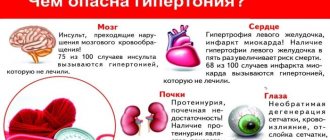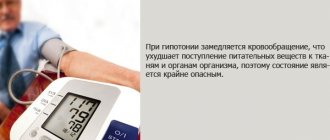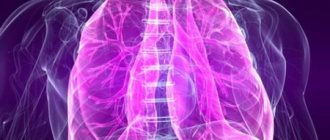Date of publication: 04/06/2017
until February 28
We're giving away RUR 1,000 for all services per visit in February More details All promotions
Blood or arterial pressure is the pressure of blood on the walls of blood vessels. It is determined by the volume of blood that the heart pushes out per unit time, and the strength of the vascular response resistance. Pressure creates conditions that allow blood to reach organs and supply them with oxygen and the nutrients it transports. It is believed that a person’s blood pressure is normal when the heart copes with its pumping function and the blood vessels remain elastic and strong.
Boundary indicators
Since the answer to the question of what blood pressure is considered normal is a certain range of values, depending on each individual person, then deviations from the norm lie in a certain range.
Because of this, there is the concept of prehypertension - a borderline state, which, if measures are not taken, easily leads to arterial hypertension. Answering the question of what pressure is considered normal at a given age, some people believe that the numbers 130-135/90-95 are the optimal value.
In fact, such results indicate a borderline state, which is dangerous because it often does not manifest itself in anything - the person feels as usual. Often it is associated not with abnormalities of the heart and blood vessels, but with other organs:
- kidneys;
- adrenal gland;
- thyroid gland.
To understand what blood pressure is considered normal specifically in your case, try keeping a monitoring diary for a month. If there are consistently high numbers (above 130/80) and jumps occur throughout the day, then even without the manifestation of any abnormalities, consult a doctor for advice. A constant overestimation of the indicator is the first signal of the onset of hypertension.
Lower and upper blood pressure
In a healthy person, the heart muscle contracts 60 to 80 times per minute at rest. With each contraction, the heart pumps another portion of blood into the arteries. Accordingly, the maximum blood pressure on the walls of blood vessels is recorded at the moment of contraction of the heart muscle. Between contractions, the heart muscle relaxes. At the time of such rest, blood pressure is at its lowest.
The highest reading is called systolic or upper pressure. The name comes from the word “systole” - the stage of contraction. The lowest pressure reading is called diastolic (from the word “diastole” - the stage of relaxation). Systole and diastole are stages of the normal cardiac cycle.
Pressure readings are traditionally recorded in millimeters of mercury. When measuring, the upper pressure indicator is always indicated first, and the lower pressure indicator second.
How does a hypertensive crisis develop?
With the development of hypertension, some pressure indicators (180/100 and above) are borderline. Due to their violation, there is a high risk of a serious malfunction - a hypertensive crisis.
This complication is accompanied by the following symptoms:
- partial or complete visual impairment (sharp darkening, “fireflies” in the eyes);
- nausea and vomiting;
- severe headaches, dizziness, noise in the head;
- dyspnea;
- compressive pain in the left side;
- less often – convulsions.
A crisis is an emergency condition: the victim suddenly becomes ill, he even loses consciousness. Calling doctors in this case is vital.
How to quickly lower blood pressure at home without medications
If your blood pressure suddenly rises to 160/90 or higher, you should relax, avoid agitation, and sit down or lie down. You can take emergency medications from the group of fast-acting ACE inhibitors, for example, Capoten (Lisinopril, Nifedipine, Moxonidine).
Let's say that there are no antihypertensive drugs at hand at all or the drugs do not help. Doctors advise using effective non-drug measures that can effectively and quickly reduce blood pressure.
- This is correct breathing.
With high blood pressure, breathing is usually shallow and not deep. We need to do the opposite. Take a deep breath, inhaling the air slowly, counting to five. And also exhale slowly. After exhaling completely, holding your breath, count to three. Inhale slowly and deeply again and exhale slowly. Repeat this several times. Then you can increase the duration of holding your breath, counting to five or even ten. The increased concentration of carbon dioxide in the blood will help restore breathing and reduce stress and blood pressure. - Hot baths for hands and feet. Hot water promotes the expansion of peripheral vessels, increases blood flow, and lowers blood pressure.
- Tea with mint. Regular peppermint works well. Warm tea will have a calming and relaxing effect, which will lead to a decrease in blood pressure.
These measures will reduce the indicators by 10-20 units. If after these actions the pressure does not drop within 30-40 minutes, or even worse, it increases, call an ambulance.
How to properly monitor your health at different ages
Blood pressure is one of those indicators that all people need to monitor - both healthy and those suffering from diseases, young and mature.
Particular attention is paid to it:
- Suffering from various pathologies of the heart and blood vessels.
- Having a tendency to have high or low blood pressure due to hereditary factors.
- Persons over 45-50 years old.
- Suffering from diseases that provoke a risk of increased blood pressure (diabetes mellitus, kidney dysfunction).
- Having undergone surgical interventions on the heart, blood vessels and other important organs.
If for people who do not fall into any of these risk groups, control consists of a periodic scheduled examination in the doctor’s office (during medical examinations), then for these categories it is necessary to monitor it systematically - daily.
To do this, consult a doctor about the norm for your specific indicator, the specifics of the course of treatment to stabilize it, and when it is best for you to measure it. Afterwards, they begin to keep a data monitoring diary, where they record daily measurements.
Normal heart rate by age
Low PD can cause:
- anemia;
- headache;
- fainting.
It should not deviate from the norm by more than 15 units.
Otherwise, it will signal diseases such as:
- heart sclerosis;
- vegetative-vascular dystonia;
- inflammatory damage to the myocardium;
- anemia.
If PD decreased and quickly recovered, this may signal the initial stage of the disease. After such leaps, you need to monitor the further functioning of the body. If falls in PD begin to become more frequent, then you should immediately consult a doctor and undergo an ECG. An increase in PP can occur during physical activity. Such jumps happen to every person.
However, if the increase in PP becomes more frequent, this indicates disorders in the body:
- renal failure;
- iron deficiency in the body;
- intracranial pressure;
- fever;
- ischemia.
It is not recommended to take medications to normalize blood pressure without a doctor determining the cause. This may worsen your health condition.
Measures to stabilize the indicator
To bring your blood pressure back to normal and successfully prevent complications from the cardiovascular system, follow a few simple rules:
- Watch your diet - do not abuse excessively salty foods, foods with animal fats, or fried foods.
- Give up bad habits or reduce them to a reasonable minimum - smoking, alcohol, overeating.
- Try to perform simple sports exercises every day to keep your body in good shape.
- Follow your work and rest schedule, and always try to get enough sleep.
- Take walks in the fresh air every day - this perfectly helps invigorate the body and fills the blood with oxygen.
Before you engage in prevention or begin treatment of pathology, be sure to get advice from a doctor - exercise standards, diet and other factors are always individual, depending on the characteristics of a particular organism. Take care of yourself and remember: prevention is easier than cure!
Normal human pressure
Monitoring blood counts is especially important for people in the older age group, since their risk of pathologies of the cardiovascular and endocrine systems exceeds 50%. In order to notice existing deviations in time, you need to know what a person’s normal blood pressure is and how it can change depending on his age.
By age (table)
Below are tables showing blood pressure norms by age for women and men. Based on these data, you can monitor vascular health and promptly seek medical help if the need arises.
Some experts deny the theory that an increase in upper and lower blood pressure in a person with age is a physiological norm, believing that even at 50-60 years old this figure should not rise above 130/90 mm Hg. Art.
Despite this, the percentage of elderly and senile people capable of maintaining indicators at this level does not exceed 4-7%.
Among women
| Age | What pressure is considered normal (mm Hg) |
| 18-22 years old | from 105/70 to 120/80 |
| 23-45 years old | from 120/80 to 130/85 |
| 46-60 years old | from 120/80 to 140/90 |
| over 60 years old | from 130/90 to 150/95 |
In men
| Age | What pressure is considered normal (mm Hg) |
| 18-22 years old | from 110/70 to 125/80 |
| 23-45 years old | from 120/80 to 135/85 |
| 46-60 years old | from 120/80 to 145/90 |
| over 60 years old | from 130/90 to 150/100 |
In children
Regular measurement of blood pressure in childhood is necessary for children at risk for heart disease, diabetes mellitus and pathologies of the genitourinary system. Children born with malformations of the heart muscle should be registered with a pediatric cardiologist, and if there is any significant deviation of blood pressure from normal values, such children should be hospitalized for a comprehensive diagnosis.
Monitoring the indicators of this biomarker is also necessary for healthy children, since many serious diseases (including kidney cancer) begin with an increase in blood pressure. In order not to miss time and start treatment on time, parents should know what the child’s blood pressure should be normally, and what can cause it to change up or down.
The table below shows normal blood pressure in children under 12 years of age:
| Age | What pressure is considered normal (mm Hg) |
| from the first day of life to two weeks of age | from 60/40 to 80/50 |
| from two weeks to two months | from 90/40 to 90/50 |
| from 3 months to 1 year | from 100/50 to 100/60 |
| from 1 year to 6 years | from 100/60 to 110/70 |
| from 7 to 10 years | from 100/60 to 120/80 |
| over 10 years old | from 110/70 to 120/80 |
The norm of blood pressure in children 10 years old is already approaching the ideal pressure in an adult and is 120/80 mm Hg. Art. If this figure is slightly lower, there is no need to worry, since the individual characteristics of the functioning of the hematopoietic system and heart muscle are of great importance. If the child’s blood pressure is higher than these values, consultation with a cardiologist and pediatrician is necessary.
In teenagers
Normal blood pressure in a teenager is no different from normal blood pressure in an adult.
| Age | What pressure is considered normal (mm Hg) |
| from 12 to 18 years old | from 110/70 to 120/80 |
Pressure is a very important indicator that reflects the condition of blood vessels and the degree of blood supply to organs. To prevent pathologies associated with the hematopoietic system, it is necessary to know what blood pressure a person should have and take all measures to maintain sufficient tone and elasticity of blood vessels.
Chronic hypertension or hypotension is equally dangerous at any age, therefore, if the arterial biomarker regularly deviates from the age norm, it is necessary to seek medical help.
Causes of increased blood pressure
Main causes of the disease:
- Poor nutrition. Foods such as lard, canned food, smoked sausages, and cheeses can provoke an increase in blood pressure. Crackers, chips, hot dogs and burgers also have a strong effect. From liquids, coffee, tea, strong alcoholic drinks and carbonated water can increase blood pressure. This list of non-recommended foods cannot be completely excluded from the diet, however, you should try to reduce their daily intake.
- Kidney diseases. If the kidneys do not work properly, urination worsens. Poor removal of fluid from the body leads to swelling and increased blood pressure.
- Side effects from taking medications. Taking medications can cause changes in the functioning of the human body. In particular, drugs for weight loss and appetite reduction can be distinguished. There are medications that weaken the effect of drugs used to treat hypertension.
- Problems with the spine. Hypertension can begin with constant tension in the spine. Working in a sitting position strains the muscles of the spine and eyes, which leads to increased blood pressure. Under the age of 40, tension goes away in the late afternoon, but in old age, the body is not able to quickly recover from fatigue, which can result in chronic hypertension.
- Impaired metabolism. When there is an excess of salt in the body, swelling appears on the face. This causes damage to blood vessels.
A large number of factors can increase blood pressure, which can only be determined with the help of special equipment. If there are any signs of the disease, you must consult a specialist and undergo diagnostics to determine the cause and further treatment.
What Causes High Blood Pressure
Photo pixabay.com
Blood pressure rises and falls throughout the day. It depends on:
- time of day;
- amount of fluid in the body;
- taking various medications;
- lifestyle;
- physical activity.
Blood pressure can also be affected by your breathing, emotions and sleep. These temporary highs are completely natural, and your blood pressure usually returns to normal when you rest.
The exact cause of persistent high blood pressure (hypertension) is often unclear. However, various lifestyle conditions are known to increase blood pressure. Among these factors:
- overweight;
- lack of physical activity;
- drinking more than two alcoholic drinks per day;
- stress;
- elderly age;
- smoking;
- family history of high blood pressure.
If hypertension is not diagnosed early, it can lead to serious health problems, including coronary heart disease.
Therefore, it is important to regularly monitor your blood pressure readings so that if you notice an increase in your normal values on a regular basis, you can seek medical help in advance and prevent a crisis.
How to determine working pressure?
The operating parameters of blood pressure, as already mentioned, depend on many different factors. Even a healthy person experiences fluctuations throughout the day under the influence of certain situations. The main thing is that the value fluctuates within the established limits - within the operating indicator.
The following recommendations will help you correctly calculate the working arterial value :
- For people under 20 years of age, use the following formula to calculate the systolic value: 1.7 times age in years and add 83.
- Diastolic pressure value: 1.6 × number of years + 42.
- For people over 20 years old to calculate systolic pressure: 0.4 × number of years + 109.
- The diastolic value is calculated using the formula 0.3 × number of years + 67.
So, a young man, 22 years old, will have the following working pressure:
- Systolic (upper): 0.4×22+109= 118.
- Diastolic (lower): 0.3×22+67= 74.
- The working pressure will be 118/74 mm. Hg Art.
This value is the best for the body, but may deviate within insignificant limits. In this case, 100/80 will also be considered normal.
The World Health Organization, based on many years of experience, has established the following limits shown in the table:
| Category | Systolic | Diastolic |
| Hypotension - low level | Less than 100 | Less than 60 |
| Optimal | Within 100-120 | Within 60-80 |
| Normal | 121-130 | 80-85 |
| High | 131-140 | 86-90 |
| Moderate hypertension | 141-160 | 91-100 |
| Moderate hypertension | 161-180 | 101-110 |
| Severe hypertension | Over 180 | Over 110 |
Problems with blood pressure can not be solved as long as you feel good and do not experience any symptoms.
What causes low blood pressure
Photo pixabay.com
Conventionally, hypotension can be divided into two groups. In the first case, a sharp drop in pressure occurs - so-called acute hypotension. She is called by:
- large blood loss;
- complications of diseases;
- dehydration (dehydration);
- disturbances in the functioning of the heart.
To treat this problem, the root cause must be addressed. Another thing is chronic hypotension. It can be caused by many more reasons:
- congenital feature of the body;
- living in high mountains;
- active sports;
- starvation;
- underlying disease (the list is huge - from diabetes to alcoholism);
- side effect of taking medications;
- stress, depression and neuroses.
Reasons for low blood pressure
A decrease in blood pressure can occur as a result of physical fatigue, stress and lack of sleep. People with low blood pressure are strictly prohibited from visiting the bathhouse and jacuzzi, since at high air temperatures, the blood vessels expand and the pressure decreases. Hypotonic patients are at risk of having a stroke if their blood pressure drops.
When taking certain medications, a side effect may be low blood pressure. Therefore, before using them, you should be sure to familiarize yourself with the contraindications. This phenomenon can occur during pregnancy. The reason is a change in blood circulation in the circulatory system.
Internal or external bleeding as a result of injury leads to a lack of blood in the vessels, which leads to a decrease in blood pressure. Pathology can occur with heart disease, such as heart failure or poor functioning of the heart valves.
Signs and symptoms of a heart attack
The most common symptoms of a heart attack are:
- chest pain
- discomfort in the upper body
- dyspnea
Other signs and symptoms include:
- sweating
- nausea
- anxiety
- swelling in the legs
Symptoms may vary by gender, but the most common heart attack symptom for both women and men is chest pain or discomfort.
Doctors believe women may experience different symptoms. For example, they may experience shortness of breath, nausea, and back and jaw pain.
Heart disease is the leading cause of death in women. Despite this, many women believe their symptoms are caused by less serious illnesses, including acid reflux, the flu, or simply aging.
What is a silent heart attack?
An asymptomatic heart attack, as the name suggests, may have few or no obvious symptoms. In some cases, people may feel tired, have flu-like symptoms, or experience indigestion or discomfort in the chest, back, arms, or jaw. This type of heart attack can sometimes be worse than a normal one, as people who have it may not receive any treatment.
An asymptomatic heart attack can only be diagnosed using an electrocardiogram.
Prevention of blood pressure deviations
A fashionable way to gradually lower blood pressure is floating , when the patient is placed in a special sealed chamber. The bottom of the capsule is filled with warm salt water. The patient is created conditions for sensory deprivation, eliminating access to any information - light, sound, etc.
The first to try this vacuum technique were astronauts. It is enough to attend this procedure once a month. Well, a more accessible and no less important procedure is regular blood pressure measurement.
The ability and habit of using a tonometer is a good prevention of most ailments. It’s a good idea to keep a diary where you will regularly note readings for monitoring blood pressure dynamics.
You can use simple but effective recommendations:
- A manual tonometer requires some skills; the automatic version can be used by everyone without any problems.
- Blood pressure should be checked in a calm state, since any stress (muscular or emotional) can significantly correct it. A cigarette or a heavy lunch distorts the results.
- Blood pressure should be measured while sitting, with back support.
- The hand where blood pressure is checked is placed at the level of the heart, so it is convenient for it to lie on the table.
- During the procedure, you must sit still and silent.
- For objectivity of the picture, readings are taken from both hands with a break of 10 minutes.
- Serious abnormalities require medical attention. After additional examinations, the doctor can decide on a way to eliminate the problem.
Is the heart capable of pumping the required volumes of blood? With age, the blood thickens and its composition changes. Thick blood moves more slowly through the vessels. The causes of such changes may be autoimmune disorders or diabetes. Vessels lose elasticity due to poor nutrition, physical overload, and after taking certain medications.
The picture is also complicated by an excess of “bad” cholesterol in the blood. Hormones or malfunctioning endocrine glands sharply change the lumen of blood vessels.
A significant part of the causes of blood pressure changes can be eliminated yourself.
Normal blood pressure is a guarantee of high performance of the heart muscle, endocrine and nervous systems, and good vascular condition. Monitor your blood pressure regularly and stay healthy!
Blood pressure in pregnant women
In healthy pregnant women, blood pressure does not change until the sixth month of pregnancy. Blood pressure is normal in non-pregnant women.
Further, under the influence of hormones, some increases may be observed, not exceeding 10 mm from the norm. In a pathological pregnancy, gestosis may occur with surges in blood pressure, damage to the kidneys and brain (preeclampsia), or even the development of seizures (eclampsia). Pregnancy against the background of arterial hypertension can worsen the course of the disease and provoke hypertensive crises or a persistent increase in blood pressure. In this case, correction of drug therapy, observation by a therapist or treatment in a hospital is indicated.
Measuring instruments
The very first devices for measuring pressure were the “bloody” devices of Stephen Gales, in which a needle attached to a tube with a scale was inserted into the vessel. The Italian Riva-Rocci put an end to the bloodshed by proposing to attach a mercury monometer to a cuff placed on the shoulder.
Nikolai Sergeevich Korotkov in 1905 proposed attaching a mercury monometer to a cuff placed on the shoulder and listening to the pressure with the ear. Air was pumped out of the cuff with a bulb, the vessels were compressed. Then the air slowly returned to the cuff, and the pressure on the vessels weakened. Using a stethoscope, pulse tones were heard on the vessels of the elbow. The first beats indicated the level of systolic blood pressure, the last – diastolic.
Modern monometers are electronic devices that allow you to do without a stethoscope and record blood pressure and pulse rate.
Methods for increasing blood pressure
Alternatively, you can drink a cup of strong coffee. This method helps with a sharp drop in blood pressure. The effect of coffee is short-lived. To increase blood pressure, you can eat foods with a lot of salt in their composition. These include lard, pickled cucumbers, salted peanuts or pistachios.
A good method is a mixture of cinnamon and honey. Add 1 tsp to a glass of boiling water. cinnamon and 2 tsp. honey. This recipe is considered potent, so for a slight increase in blood pressure you need to consume 1 tsp of the mixture. at a time.
Cognac and red wine are also good for raising blood pressure. If you drink no more than 1 glass of wine per day, blood pressure will remain normal due to good blood circulation in the vessels. It is recommended to make your lifestyle more active. Go for morning jogging, do exercises and exercises. Change your diet to one that contains the most iron (apple, buckwheat porridge, liver, banana, pomegranate, pineapple and nuts).
Table of normal heart rate for men 20 – 80 years old
Heart rate depends on the speed and force of blood being pumped out of the heart. The greater the force of blood ejection, the lower the heart rate. The more effort it takes for the heart to pump out enough blood, the stronger the pulse.
The normal heart rate for men by age is shown in the table:
| Age | Pulse value |
| 15-19 | 65 — 75 |
| 20-24 | 63 — 72 |
| 25-30 | 60 — 70 |
| 35-40 | 60 — 80 |
| 50-60 | 60 — 70 |
| 65-70 | 60 — 75 |
| 75-80 | 60 — 65 |
| Over 85 | 55 — 65 |
What are the dangers of low blood pressure?
Hypotension does not threaten life, but reduces its quality.
The following ailments appear:
- performance decreases due to increased fatigue and drowsiness;
- frequent dizziness and headaches occur;
- fainting occurs;
- periodically the person breaks out in cold sweat;
- arms and legs are shaking.
Adequate rest is of great importance to prevent the onset of illness. After all, a person is at the point where he is about to retire, but he is no longer able to work fully due to accumulated fatigue. Therefore, at least once a year it is necessary to change the environment, go to a resort, or even better to a sanatorium. For example, in the “Zabota” boarding houses, blood pressure is measured twice a day and the health status of an elderly person is monitored.
Do tea and coffee affect blood pressure readings?
Medical opinions differ regarding the effects of hot or cold black tea on the body. Some do not recommend it for hypertensive patients due to the high concentration of caffeine, others believe that this drink tones blood vessels and lowers blood pressure. Green tea is especially useful in this regard, as it has the ability to normalize any blood pressure when consumed regularly and correctly.
Natural coffee gently increases blood pressure in hypotensive patients. It cannot increase blood pressure to a critical level for hypertensive patients, but they should not abuse this drink.
Many are probably familiar with the results of an experiment by French scientists who suggested that twin prisoners with life sentences drink only tea every day for one and coffee for the other in order to find out which of the brothers would live longer. The prisoners outlived all the scientists involved in the study and died well into their 80s, with only minor differences.
What is high blood pressure
Photo pixabay.com
Blood pressure over 130/80 mm Hg. Art., as a rule, is considered high. When blood pressure is high, the heart and arteries can become overworked. High blood pressure can accelerate the buildup of plaque on artery walls (atherosclerosis), clogging blood flow to the heart muscle and putting you at risk of a heart attack.
It also weakens the walls of arteries in the brain, which can lead to stroke. High blood pressure can also affect arteries in other parts of the body, such as the eyes, kidneys and legs.
Long-term high blood pressure is known as hypertension and is a major risk factor for developing cardiovascular disease.











